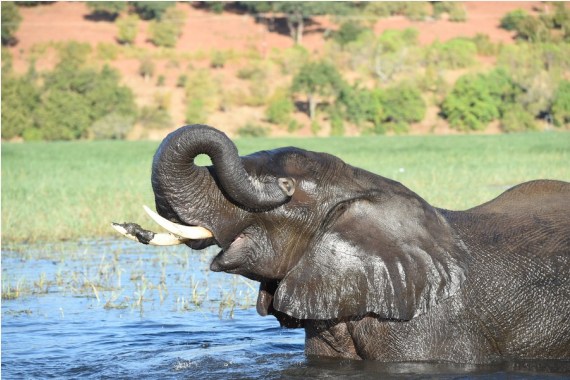By Xinhua
WINDHOEK, Sept. 2 (Xinhua) — Elephant population remains stable in conservation areas in southern African countries, according to a research report.
The Kavango Zambezi Transfrontier Conservation Area (KAZA TFCA), which includes Angola, Botswana, Namibia, Zambia and Zimbabwe, countries in southern Africa with borders along the Okavango and Zambezi River basins, has an estimated elephant population of almost 227,900, said the report released Thursday.

An elephant is seen in the Chobe River in northwest Botswana’s Kasane, May 10, 2021. (Photo by Tshekiso Tebalo/Xinhua)
Namibia is estimated to have 21,090, while Zimbabwe has 65,028, and Botswana with the largest estimate of 131,909, while Angola and Zambia have 5,983 and 3,840, respectively, according to the report.
This was revealed Thursday when leaders of the KAZA TFCA, led by ministers from Namibia, Zambia and Botswana as well as heads of delegation from Angola and Zimbabwe, published the results of the 2022 KAZA Elephant Survey. The survey was flown from August to October 2022 during the dry season when elephants can be more readily seen.
The report was released at a time when there was an urgent need for robust scientific data to guide policy and decision-making including management of human-wildlife conflict, said Heather Sibungo, Namibia’s minister of Environment, Forestry and Tourism, in a statement.

Baby elephants play at an elephant nursery in Lilayi, south of Lusaka, Zambia, on July 30, 2021. (Photo by Martin Mbangweta/Xinhua)
According to Sibungo, elephants are charismatic wildlife species that attract so much public attention and interest.
“Our KAZA TFCA supports the great number of the African Savannah elephants, and is an important global role player and a leader in the conservation of the species,” she said.
According to the Executive Director of the KAZA Secretariat Nyambe Nyambe, the unprecedented aerial survey was undertaken to provide an accurate estimate of the number of live elephants, elephant carcasses, and other large herbivores in this region that is home to more than half of the savanna elephant herds in Africa.
“This rich data set now allows us to understand the health of our ecosystems and implement best practices for wildlife management and human-wildlife coexistence,” he added. ■









